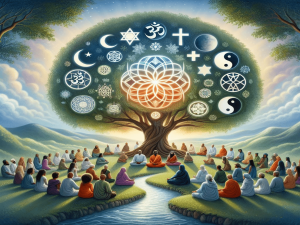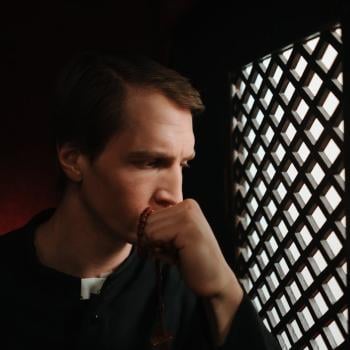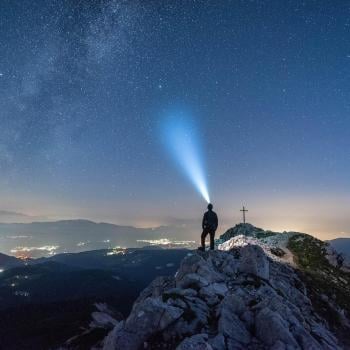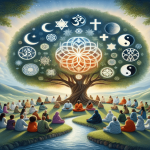There are common themes that recur in many religions, and they are consistent in general. Of course, they do not always agree on the details. This column is subtitled “An Interspiritual Journey.” Often, I highlight some of the common themes and differences in spiritual traditions.
I know—as well as I know anything—that everyone is related, and everything is connected. Fundamentally, that is all that I need to know. This realization produces the Golden Rule, which is a common theme in many spiritual (and secular) traditions.
But I do NOT know (for example) if Jesus or Osiris were born of virgins or if Jesus or Odin rose from the dead. And I do not need to know. Also, I do NOT know whether we are punished or rewarded or reincarnated or snuffed out when we die. And I do not need to know.

So this is how Common Ground Interspiritual Fellowship describes interspirituality:
- It is NOT a new religion.
- It is NOT a replacement for your spiritual path.
- It is NOT a blending of all paths.
- It is NOT trying to identify who has the right belief.
- It is a willingness to find wisdom regardless of the label it is expressed within.
- It is an attitude of respect and appreciation for those who have traveled ahead of us.
- It is a focus on experiences of heart and unity consciousness rather than on creeds and beliefs.
- It is a recognition of a common mystical basis and experience within all the great wisdom traditions.
But how does that look?
The Moon and the Finger Pointing at the Moon
We are spending another month in Crestone, Colorado, which is home to numerous spiritual centers in various spiritual traditions. One day, we might be praying to Our Father at a Catholic Mass. The next day, we might be chanting to the Divine Mother at a Hindu ashram.
(I write about a Hindu fire ceremony here. This was a popular post, since many readers have never experienced a fire ceremony.)
If you read my book or my columns, you know that I recognize an Ultimate Reality, which some might call God or Source or the Universe. None of us know anything about Ultimate Reality. “The Tao that can be named is not the eternal Tao,” as the Taoists say.
I suspect that Ultimate Reality is probably not personal, possibly not supernatural, and perhaps not even intentional. In The Way, I ask whether we should think of God as the architecture of the universe (that which connects us), rather than the architect of the universe.
If God is NOT personal, if there is NOT a literal Father, and if there is NOT a divine intention, then what is the point of chanting or praying? There is a Buddhist saying that one should not confuse the finger pointing at the moon with the moon. Chanting and praying are pointers.
- Books like the Bible and the Bhagavad Gita are pointers.
- Concepts like “God” or “the Universe” are pointers.
- Practices like chanting and praying are pointers.
- Rituals like church services and fire ceremonies are pointers.
- And teachers like Buddha and Jesus are pointers.
Pointers prompt awe, gratitude, and reverence for living, without needing to know (or pretending to know) the Mystery behind the gift of life.
The moon looks like a flat disk when viewed from one perspective. But it shows itself to be a sphere when viewed from several perspectives. To me, the pointers from the various religions reveal a consistent picture in general. But they might not agree on the details.
The Guru, the Priest, and the Zen Master
Yesterday, I bought an interesting book in the ashram gift shop, Zen and the Mystic Impulse: Reflections on the Teachings of Willigis Jäger, Benedictine Monk, Mystic, and Zen Master by Arnie Lade. Why would a Hindu ashram carry a book about a priest and Zen master?
In the book, Lade pays homage to his three primary spiritual teachers:
- Haidakhan Babaji was a Hindu teacher, “a personification of what it means to be truly human, in communion with the Eternal.”
- Reverend Master Meiten was a Zen Buddhist teacher, a professor of psychology who once lived at an ashram.
- Willigis Jäger was a Catholic priest and Zen master.
All three were mystics, who drew insight and inspiration from several traditions.
Lade writes that Sufi mystic Hazrat Inayat Khan said, “No one can be a mystic and call himself a Christian mystic, a Jewish mystic or a Muhammedan mystic. For what is mysticism? Mysticism is something that erases from one’s mind all ideas of separation.”
And Lade explains that “Mysticism is all too frequently misunderstood and confused with lofty, ecstatic states and paranormal experiences… The aim is not some self-centered detached ecstasy but the recognition and union with the Eternal and becoming a whole person.”
Willigis Jäger wrote, “The mystic goes beyond Western dualistic thinking that separates God and the world, the natural and the supernatural, the human and the divine.” And he wrote, “In the willingness to surrender, the new can unfold, and the process of maturation takes place, a process of becoming totally whole in our lives. This experience led the Zen master Ummon to say: ‘Every new day is a good day.'”
There are Common Themes that Recur in Many Religions
In The Way, I discuss the perennial philosophy, a school of thought that recognizes the common themes across all traditions. Of course, Jäger recognized the perennial philosophy, and Lede wrote about it in his book.
There are many Christian and non-Christian communities that are less doctrinal, more inclusive, and less evangelical than conservative Catholic, Evangelical or Mormon churches. I belong to a Unity book club, and I lead a Christian deconstruction study group at a UU church. Weekly, I zoom with progressive Christians. Monthly, I attend Buddhist book club meetings, Quaker meetings, and Zen meditations.
Sometimes, I participate in Hindu fire ceremonies, Native American sweat lodges, Shinto purification ceremonies, and Sufi dhikrs. Recently, a Hindu ashram appointed my wife to the board of directors. The board recognized that her interspiritual perspective was valuable.
Do you see why an ashram bookstore carries a book about a Catholic priest and Zen master? Do you see why many people receive insight and inspiration from the “pointers” in several traditions that recognize an Ultimate Reality that cannot be contained in one tradition?
And do you see why many people seek wholeness in contemplative spiritual practices that focus on our interconnectedness, without promoting some of the speculative doctrine, supernatural beliefs or unkind practices that characterize some spiritual traditions?
There are common themes that recur in many religions, and they are consistent in general. Of course, they do not always agree on the details.












